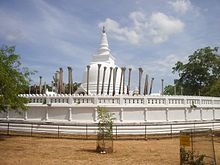Thuparamaya
| Thuparamaya | |
|---|---|
ථූපාරාමය | |
Devanampiya Tissa (247-207 BC) | |
| Specifications | |
| Width | 18 m |
| Height (max) | 50.1 m |
Thuparamaya is the earliest documented Buddhist temple in Sri Lanka. Its building dates to the arrival of Mahinda Thera (Mahindagamanaya) and the introduction of Buddhism to the island.
Located within the sacred precinct of
History

Thuparamaya is closely linked to
According to the
The Stupa
Thuparamaya dagoba was built in the shape of a bell. This dagoba was destroyed from time to time. By the reign of King Aggabodhi II the site was in ruins and was fully restored by royal edict. The current construction of the dagoba dates to the 1842 rebuilding.[6] As of the 21st century after repeated renovations over centuries, the monument has a diameter of 59 ft (18 m), at the base. The dome is raised on a plinth 11 feet 4 inches (3.45 m) off the ground, and the entire structure is 164+1⁄2 ft (50.1 m) in diameter. The compound is paved with granite with two rows of stone pillars ringing the dagoba. These are remnants of the roofed vatadage once built over Thuparamaya.

See also
References
- ISBN 81-207-2536-0.
- ^ "Archaeological Sites (Map)". Department of Archaeology. Retrieved 20 September 2017.
- ISBN 9781481795517.
Accordingly the right collar-bone of the Buddha was received with great veneration and pomp and enshrined
- ^ Royal Asiatic Society of Sri Lanka, Royal Asiatic Society of Great Britain and Ireland. Sri Lanka Branch (1990). Journal of the Royal Asiatic Society of Sri Lanka, Volume 33. Royal Asiatic Society of Sri Lanka. p. 10.
...to the building of the Thuparamaya, the first stupa to be built in Lanka to enshrine the right collar-bone relics of the Great Teacher (Buddha).
- ^ "To protect oldest stone inscription Irrigation Dept constructs wall". Ceylon Today. Ceylon Newspapers (Private) Limited. 11 September 2017. Retrieved 20 September 2017.
- ^ "සෙල්ලිපියට කොන්ක්රීට් දැමූ පින්වතුන්! (In Sinhala)". Deshaya. Wijeya Newspapers. 16 September 2017. Retrieved 20 September 2017.
